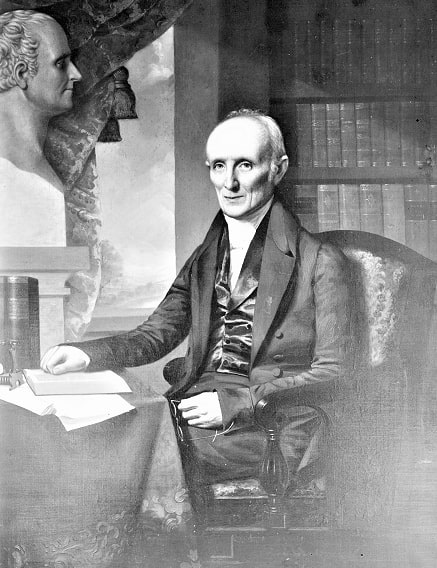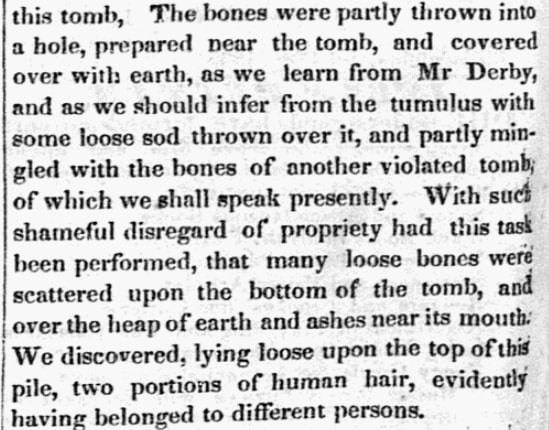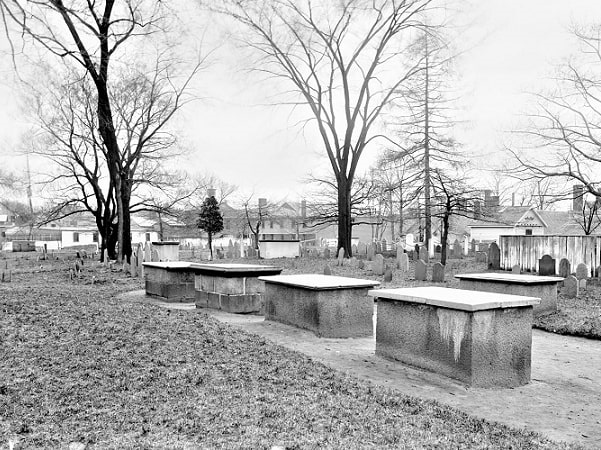Introduction: In this article, Melissa Davenport Berry continues her story about a controversy in Salem, Massachusetts, over the treatment of some Quaker tombs in 1835, focusing on Dr. Nathaniel Bowditch. Melissa is a genealogist who has a blog, AnceStory Archives, and a Facebook group, New England Family Genealogy and History.
Author’s Note: I came across this story while researching the 17th century Quaker families in Salem, Massachusetts. They are the ancestors of the tombs in Salem that are the focus of today’s story. A list of these Salem Quakers can be found in Jonathan M. Chu’s book Neighbors, Friends, or Madmen: The Puritan Adjustment to Quakerism in Seventeenth-Century Massachusetts Bay (p. 169-173). These Quakers are also cited in the court documents available online at the University of Virginia site.
To recap: In 1835 the Board of Health in Salem placed an announcement in the newspaper which created a sensation. The board reported that several tombs in public burial grounds were in a ruinous state, and requested owners to come forward to mark the appropriate names and fix up the tombs. For tombs left unclaimed or undefined, the board announced that it would repair – and then sell – those tombs.

After the Board of Health had some of the remains (both bones and ashes) removed in preparation for the repair and sale of the tombs, two of the tombs’ owners – Jonathan Ingersoll Bowditch and Lucius Manlius Sargent – found out what was going on and came to the burying grounds to examine what had been done. Bowditch and Sargent were horrified by what they found, as they reported in a letter published in the Salem Gazette.

Not only was the legality – and morality – of the Board’s actions being questioned, there was even some doubt if the tombs were really in the state of disrepair the Board claimed. Another Bowditch, Dr. Nathaniel Bowditch, reported that he personally saw to the repair of two of the tombs in question – those of John Turner and Robert Kitchen – just 12 years before!
Dr. Bowditch, along with the Sargent and Derby families, made a very public appeal to the Selectmen of the town of Salem.
When the Selectmen told the outraged families that their issue was with the Board of Health, not them, Dr. Bowditch and the Sargent and Derby families – joined by a member of the Winthrop family – next made a public appeal directly to the community of Salem.
This emotional appeal reads:
“The Board have formally and officially taken possession of the tombs of our ancestors, whose bones they have cast forth, and which are lying, at this moment, more or less exposed to the gaze of idle curiosity, in the burying grounds of Salem. The Board have publicly advertised these tombs for sale. We turn for redress to the Selectmen; they have no power in this respect; and the Board of Health intimate not their willingness to grant us the slightest satisfaction for the wrong. The act of ownership remains, to the best of our knowledge, unreversed upon the records of that Board.
“We cherish an affectionate respect for the ancient residence of our ancestors, the town, where they were born, and where they were buried; and we now ask the good citizens of that town, we ask them, in a kind and Christian spirit, which teaches us to live as peaceably as possible with all men, will they permit us to enquire of the legal tribunals of our country, if our ancestors have or have not a right to sleep in their peaceful graves?
“The delay even of a single day, under the well known, existing circumstances of the case, is eminently painful to our feelings; but we are disposed that patience should have its perfect work: we desire to avoid, on our part, that course of precipitancy and error, whose effects we have such present reason to deplore in the conduct of others.”
Continuing to research this story, I found a passage worthy of mention in Memoir of Nathaniel Bowditch, authored by Nathaniel Ingersoll Bowditch (the son of Dr. Bowditch):
“Dr. Bowditch often mentioned that his grandmother [Mary Bowditch née Turner], on her deathbed, refused to be buried in this tomb, saying that, many years before, at the funeral of one of the family, a mourner took up her father’s skull, and holding it before her, said, ‘This is the skull of an Indian warrior.’ She seemed to have a prophetic dread of the possibility of the outrage subsequently to be committed and preferred that her remains should be consigned to the safer custody of her parent earth.” (p. 118)
Despite Mary’s concerns, her ashes were deposited in the Turner tomb, to be among the ashes of all her relatives of many former generations.
Genealogy Note: Mary (daughter of John Turner II and Mary Kitchen) married shipmaster and merchant Ebenezer Bowditch.
According to Memoir of Nathaniel Bowditch:
- The Salem Board of Health reconsidered their decision to empty, repair and sell the tombs, and “none indeed, apparently, at last regretted it more sincerely than themselves.” (p. 119)
- Shortly after city authorities in Boston tried to disturb an ancient burial spot to lay out a public way, “Dr. Bowditch waited on those gentlemen” and “wholly succeeded in conquering the repugnance, which he satisfied them ought to yield to other and higher considerations.” (p. 119)
And this is not the only grave matter from this area. In 2018 a missing tombstone was found in a Scituate, Massachusetts, garage.
According to the Salem Evening News, the tombstone was connected to the children born to Dr. Bowditch’s gr. grandparents William Bowditch and Mary Gardner. Read about it here: “Missing Bowditch gravestone found in Scituate Stone marks mysterious, yet historic, grave.”
Stay tuned for more on the Salem tombs…
Note: Just as an online collection of newspapers, such as GenealogyBank’s Historical Newspaper Archives, helped tell the stories of the families connected to the Salem tombs, they can tell you stories about your ancestors that can’t be found anywhere else. Come look today and see what you can discover!
Related Articles:
